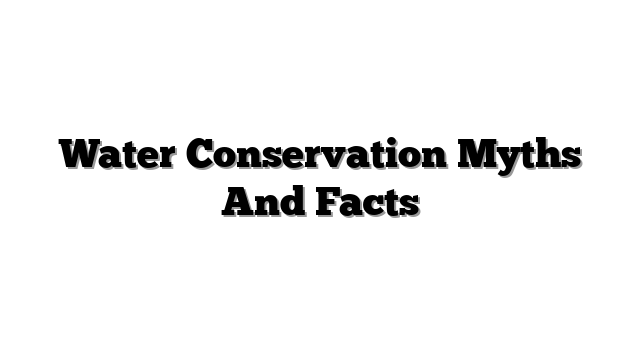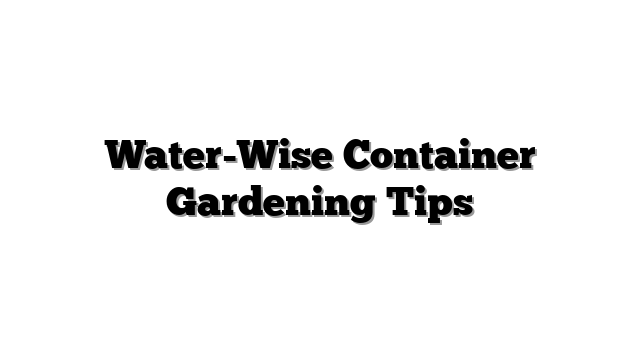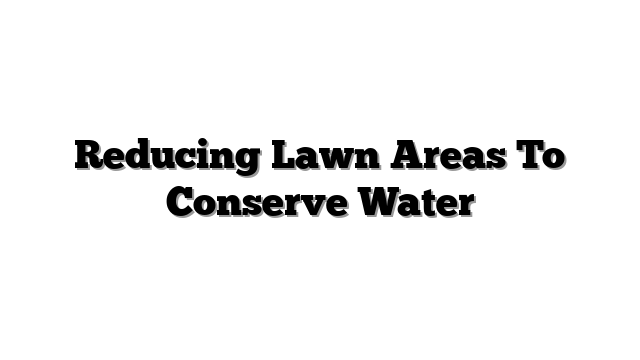Water Conservation Myths And Facts
Your garden needs water. Green leaves need water. Flowers need water. But water costs money. Wasting water is bad. Many people water wrong. They follow old ideas. These ideas are not true. They are myths. These myths hurt your garden. They waste precious water. We can help you water smart. We share real facts. We show you how to water right. Your plants will be happy. You save water too. This helps your wallet. It helps the Earth. Let us learn about water. We learn about your garden. We find the best ways. We find smart ways to water. We will bust myths. We will find the facts. We talk about soil. We talk about plants. We talk about weather. We cover watering tricks. We look at plants that use less water. We check out new garden ideas. We talk about clever garden design. Get ready to water smart.
Debunking the Most Common Garden Watering Myths
Bad ideas about water spread. These myths hurt your garden. They make you waste water. Let us look at some big myths. We find the truth instead. This helps us water smart. We save water. Our plants grow strong.
Myth 1: Watering a little bit every day is best.
Many people water a little bit. They water every single day. This feels right. It seems helpful. But this does not help plants much. The water stays near the top. Plant roots stay near the top. They do not grow deep. Deep roots are strong roots. They find water when it is dry. Shallow roots mean weak plants. They cannot handle hot weather.
Fact: Water plants deeply. Water them less often. This makes roots grow down. Deep roots find water underground. Plants become strong. They handle dry times better.
Actionable Tip: Check how deep the water goes. Use a stick or small shovel. Push it into the soil. Push it after you water. The soil should be wet down deep. Aim for 6 inches deep. Deeper is even better. We want wet soil down there.
Myth 2: Watering the leaves cools the plant down.
Someone might spray water on leaves. They think this cools things. They water the top of the plant. This is not a good idea. Much water goes away. The sun dries it fast. This is wasted water. Wet leaves can cause sickness. Water sitting on leaves is bad. Fungi like wet leaves. Diseases can start there. Water needs to go to the roots.
Fact: Water the soil. Water near the plant base. The roots take up water there. Leaves do not drink water. Watering the soil is smart. It is efficient. It keeps leaves dry. This stops many diseases.
Actionable Tip: Point your hose low. Aim for the soil. Water the dirt around the plant. Do not spray the leaves. Water gets to the roots fast.
Myth 3: All plants need the same amount of water.
Some people water everything the same. They give all plants equal water. This is not correct. Plants are like people. They have different needs. A small flower needs less. A big bush needs more. Some plants like dry soil. Some plants like wet soil. Giving all plants the same water is wrong.
Fact: Plants need different water amounts. It depends on the plant type. It depends on plant size. It depends on where it grows. Sun or shade matters. The soil matters too. We must know our plants. We must know their needs.
Actionable Tip: Learn about your plants. Read the tag. Ask at the garden store. Know if they like wet or dry soil. Group plants with like needs. Put dry-loving plants together. Put water-loving plants together. This helps watering.
Myth 4: If a plant is wilting, it always needs water.
Seeing a plant droop is sad. We think it is thirsty. We grab the hose fast. Wilting can mean thirst. But wilting has other causes. Too much water makes plants wilt. Roots cannot breathe in wet soil. They drown. Then the plant wilts. Heat stress can cause wilting. The plant loses water fast. It cannot take it up fast enough. Check the soil first.
Fact: Check the soil first. Wilting means something is wrong. It does not always mean dry. Feel the soil near the roots. Is it dry? Water it. Is it wet? Do not water. Wet soil and wilting mean too much water.
Actionable Tip: Use your finger. Push it into the soil. Go down two inches. Is it dry there? Water. Is it wet? Wait to water. A soil moisture meter also helps. It tells you about the soil. It tells you if it is wet or dry deep down.
Myth 5: Sprinklers are the most efficient way to water a large area.
Sprinklers look easy. They cover a big area fast. But sprinklers waste lots of water. The water sprays high. Wind blows the water away. The sun dries it fast. Much water never hits the soil. It lands on paths. It lands on the street. This water is lost. It does not help plants.
Fact: Sprinklers lose water easily. Wind and sun take it. Other systems are better. Drip lines put water right on the soil. Soaker hoses sweat water out. They put water at the plant roots. These methods save much water.
Actionable Tip: Use sprinklers less. Use drip or soaker hoses. Put them in garden beds. They water plants directly. They use less water overall. We save water. Our plants get water where they need it.
Understanding Your Garden’s True Water Needs: Soil, Plants, and Climate
Watering smart needs knowledge. We must know our garden. We must know its parts. The soil is important. Our plants are important. The weather is important too. Knowing these helps us water right. We save water this way.
Soil Types and Water Retention:
Dirt is not just dirt. Soil is different everywhere. Some soil is sandy. Water runs through sand fast. It does not hold water well. Clay soil is different. It holds water tight. Water drains slowly in clay. Loam soil is a mix. It holds some water. It lets some drain. It is good soil.
We can make soil better. Add compost to your soil. Compost is decayed plants. It is dark and crumbly. Compost helps sandy soil. It helps it hold more water. Compost helps clay soil. It makes spaces for water to drain. Better soil means happier plants. It means less watering needed.
Actionable Tip: Check your soil type. Grab some soil. Make a ball. Does it fall apart fast? It is sandy. Does it stay in a tight ball? It is clay. Does it make a ball but break apart easily? It is loam. Add compost every year. Mix it into your garden beds.
Reading Your Plants:
Plants show us things. They tell us their needs. Their leaves change color. They might look dull. They might droop down. These are signs. These signs mean something. They might need water. But remember wilting. Wilting can mean too much water.
The best way is to check the soil. Look at the plant. Then check the dirt. Push your finger in. Go down a few inches. Is it dry way down? The plant needs a drink. Is it wet down there? Do not water yet. This check is the most sure way.
Actionable Tip: Check the soil regularly. Check it near the plant roots. Do not just look at the top. The top dries fast. The soil deeper matters more. Use your finger test. Or use a soil meter. Do this before you water.
Climate and Microclimates:
The weather affects watering. Rain helps a lot. We do not need to water after rain. Hot days make plants thirsty. Wind dries out soil fast. Humidity makes plants less thirsty. Know your local weather.
Your yard has different spots. Some spots get full sun. They get hot. They dry out fast. Some spots are shady. They stay cooler. They stay wetter longer. These are microclimates. They are like little different weather areas. Plants in hot spots need more water. Plants in shady spots need less.
Actionable Tip: Watch your yard. See where the sun shines strong. See where the shade is. Group plants by these spots. Water hot, sunny spots more often. Water cool, shady spots less often. Adjust your watering plan.
Mastering Efficient Watering Techniques
We know the myths are wrong. We know about soil and plants. Now we learn how to water. We learn smart ways. These ways save water. They help plants a lot. Let us get practical. We water the best way.
Timing is Key:
When you water matters. Watering at the wrong time wastes water. It can hurt plants. The best time is morning. Water early in the day. The sun is not strong yet. The air is cool. Less water disappears. Water goes into the soil. Plants get ready for the heat. Their roots take up water.
Watering in the evening is okay sometimes. But it can leave leaves wet. Wet leaves at night can get sick. Watering in the middle of the day is bad. The sun is hot. Wind blows water away. Most water evaporates. It turns into air. It does not reach the roots. This is wasted water.
Actionable Tip: Water before 10 AM. Water between 5 AM and 9 AM. This is a good rule. Set a timer on your phone. Make watering part of your morning. It saves water. It helps plants stay healthy.
Deep vs. Shallow Watering:
We talked about this myth. Watering a little bit daily is bad. It makes roots weak. We want deep roots. We must water deeply. Water for a longer time. Water less often. This makes water go down deep. Roots follow the water. They grow strong and deep.
How long should you water? It depends on your soil. Sandy soil needs shorter times. Water sinks fast. Clay soil needs longer times. Water sinks slowly. Test your soil after watering. Use a stick or probe. See how deep the water went. Aim for 6-12 inches deep.
Actionable Tip: Water slowly and deeply. Do not rush it. Let the water soak in. Water one area. Move to another. Then water the first area again. This helps water go down deep. Check the depth after you water.
The Magic of Mulch:
Mulch is a garden helper. It is material covering the soil. Wood chips work. Straw works. Grass clippings work. Mulch saves water. It covers the soil surface. The sun does not hit the dirt directly. Less water evaporates. It stays in the soil for roots.
Mulch also stops weeds. Weeds steal water from plants. Less weeds mean more water for your plants. Mulch keeps soil cool in summer. It keeps soil warm in winter. It is very helpful.
Actionable Tip: Put mulch around plants. Keep it a few inches deep. Do not pile it against the plant stem. Leave a small space. Mulch the whole garden bed. It looks nice too.
Targeted Delivery Systems:
Sprinklers waste water. We know that now. Better ways exist. Drip irrigation is one. It is a system of tubes. Small holes drip water out. The water drips right at the plant base. It goes straight to the roots. Very little water is lost.
Soaker hoses are similar. They are like leaky hoses. Water sweats out along the hose. You lay the hose next to plants. The water goes into the soil. It goes to the roots. Both drip and soaker hoses are great. They are much better than sprinklers for beds.
An expert said, “Targeted watering saves gallons.”
Actionable Tip: Think about drip systems. Or use soaker hoses. Put them in your garden beds. Use sprinklers only for lawns. Or maybe not even for lawns. These systems use water wisely.
Choosing Plants for a Water-Wise Landscape
Plant choice matters a lot. Some plants need lots of water. Some plants need very little. Choosing plants that need less water is smart. It saves water from the start. We can have a beautiful garden. It does not need constant watering.
Embracing Drought-Tolerant Plants:
Some plants can live with less water. They handle dry times well. We call them drought-tolerant. They have special ways to save water. Some have thick, waxy leaves. Water does not escape easily. Some have fuzzy leaves. The fuzz traps water. Some have silver leaves. Silver reflects sun. This keeps them cool. Some have deep roots. Roots find water deep down. Cacti are drought-tolerant. Succulents are too. Many herbs handle dry soil. Lavender does well. Rosemary does well.
Actionable Tip: Look for drought-tolerant plants. Ask at the garden center. Read plant tags. Find plants that like less water. Choose plants for your area. What grows well naturally?
The Power of Native Plants:
Native plants are special. They grew in your area for a long time. They are used to the local rain. They are used to the local soil. They do not need extra water often. Once they are settled, they are happy. They need less care overall.
Native plants help local bugs and birds. They are part of the natural world. They make your garden part of that world. Planting native is a great choice. It saves water. It helps nature.
Actionable Tip: Find native plants for your region. Search online for “[Your State/Region] native plants”. Local garden groups can help. Plant native plants in your garden. They will feel at home.
Xeriscaping Principles:
This big word means low-water gardening. It is a way to design your yard. It uses little water. It is not just rocks and cacti. It can be very pretty. Xeriscaping has simple rules. Plan your garden well. Improve the soil. Choose plants that need little water. Use smart watering. Use mulch. Have less lawn. Keep up the garden.
A study showed xeriscaping saves water. One study found 50% less water used. That is a lot of water.
Actionable Tip: Think about xeriscaping ideas. Reduce your lawn size. Add garden beds with low-water plants. Use mulch everywhere. Design zones for different water needs.
Leveraging Technology and Sustainable Practices
Gardening changes over time. New tools help us. Smart ideas help us. We can use technology. We can use good practices. This helps us save even more water. The garden of the future uses water wisely.
Smart Irrigation Systems:
These are like smart brains for watering. They connect to the internet. They check the weather forecast. They know if it will rain. They can check soil moisture too. They know what plants you have. They water only when needed. They water the right amount.
Smart systems save water. They save you time. They help plants stay healthy. You do not have to guess. The system does the thinking. There are different types. Some replace your old timer. Some use sensors in the soil.
Actionable Tip: Look into smart irrigation. Maybe replace your old timer. Or add soil sensors. It can be a good investment. It saves water and money over time. This is a trend for 2025 gardens.
Rainwater Harvesting:
Rain falls from the sky. It is free water. It is good water for plants. It has no chlorine. We can catch this water. This is rainwater harvesting. The easiest way is a rain barrel. Put a barrel under a roof drainpipe. The rain fills the barrel.
You can use this barrel water. Water your plants with it. Use a watering can. Or connect a hose. Collecting rain saves tap water. It is simple and effective. Some places have rules about this. Check your local rules first.
Actionable Tip: Set up a rain barrel. Connect it to a downspout. Make sure it is stable. Use the collected rain for watering. It is free, natural water.
Other Sustainable Approaches:
Think about greywater. This is water from sinks or showers. It is not toilet water. Some people use greywater. They use it for non-food plants. This is complex for homes. It needs special systems. It is often not allowed by rules. Be careful with this idea. Focus on simple things first.
Think about your lawn. Lawns need much water. Reduce your lawn area. Plant garden beds instead. Use plants that need less water. Use materials that let water soak in. Stone paths can let water through. This is better than solid concrete. Water goes into the ground.
Vertical gardens are also smart. Plants grow up walls or frames. Some vertical systems use water very well. They recycle water. This can save water too. It is a modern garden idea.
Actionable Tip: Reduce your lawn. Add low-water plants. Use mulch. Think about rain barrels. Explore sustainable ideas.
Designing and Maintaining Your Water-Wise Garden
We learned many things. Now we put it all together. We design our garden smart. We keep it healthy. We use less water this way. It is a complete plan.
Implementing Hydrozoning:
Remember different plant needs? Some like wet, some like dry. We group plants by their water needs. This is hydrozoning. Put plants needing lots of water together. Put plants needing little water together. Put plants needing medium water together.
This makes watering easy. You water one zone differently. You give the high-water zone more. You give the low-water zone less. You do not overwater some plants. You do not underwater others. Everyone gets what they need. You save water overall.
Actionable Tip: Draw your garden. Map the sun and shade. Map your plants. Group plants with similar water needs. Make watering zones. Water each zone based on its plants.
Reducing Water-Intensive Areas:
Lawns use the most water. Big lawns need much water. Think about making your lawn smaller. Replace some lawn with garden beds. Use plants that need less water. Add mulch in these beds.
Use stepping stones for paths. Or use gravel paths. These let water soak into the ground. Concrete paths do not. Rainwater runs off concrete. It goes down the drain. We want rain to soak into the soil. This helps the ground stay moist. It helps nearby plants.
Actionable Tip: Plan to shrink your lawn. Start small. Change one area this year. Replace grass with mulch and low-water plants. Add a permeable path.
Watering Container Plants Efficiently:
Plants in pots dry fast. They need special care. The pot size matters. Bigger pots hold more water. The pot material matters. Plastic holds water better than clay. Good soil mix helps. Use potting mix that holds some water.
Group pots together. They make a little moist area. This helps them stay wet longer. Check pots often. Stick your finger in the soil. Go down two inches. Is it dry? Water deeply.
Actionable Tip: Check pots daily in hot weather. Choose bigger pots. Use good potting mix. Group pots. Consider self-watering pots. Or add a drip emitter to each pot.
Ongoing Maintenance for Water Savings:
A water-wise garden needs care. Check your watering system. Look for leaks. Fix them fast. A small leak wastes much water. Adjust your watering plan. Water less when it rains. Water more when it is hot and dry. Change watering as seasons change.
Pull weeds often. Weeds steal water. They take it from your plants. Keep the mulch thick. Add more mulch if it is thin. Mulch helps save water. These small tasks help a lot.
Actionable Tip: Check your system each month. Walk your garden often. Pull weeds when you see them. Add mulch once or twice a year. Make a simple checklist.
FAQs: Answering Your Top Watering Questions
People have questions about water. They want clear answers. Here are some common ones. We answer them simply.
Okay, so how often should I water my garden?
Do not water every day. That is a myth. Watering depends on many things. It depends on soil type. It depends on the plant. It depends on the weather. The best way is to check the soil. Push your finger down 2 inches. Is it dry? Then water. If it is wet, wait. This is the best rule.
What is the best time of day to water plants?
Water early in the morning. This is the best time. It is cool. The sun is not strong. Less water disappears into the air. Plants can drink the water. They get ready for the hot day. Watering in the middle of the day wastes water. Watering at night can make plants sick.
How can I tell if my plant has enough water?
The best way is to check the soil. Feel the soil near the plant roots. Push your finger down. Is it wet deep down? Your plant has enough water. Is it dry deep down? Your plant needs water. Plants might droop when dry. They also droop when too wet. Checking the soil is key.
Do native plants really use less water?
Yes, usually they do. Native plants grew here naturally. They are used to the local rainfall. They are good with the local soil. They do not need extra water often. This is true once they are grown. They save water. They help local wildlife too.
What are the signs of overwatering vs. underwatering?
It can be tricky. Both can make plants wilt. Check the soil first. Is the soil wet? And the plant wilts? That is likely overwatering. The roots are drowning. Is the soil dry? And the plant wilts? That is underwatering. The plant is thirsty. Leaves might turn yellow too. This can be either problem. Check the soil always.
Conclusion
We learned about garden water. We busted old myths. We found true facts. Watering a little every day is bad. Watering leaves is not smart. All plants need different water. Wilting does not always mean dry. Sprinklers waste water. Knowing your soil helps. Knowing your plants helps. Knowing the weather helps.
Watering early is best. Water deeply, not often. Use mulch to save water. Drip systems are smart. Choose plants that need less water. Native plants are great. Plan your garden zones. Reduce your lawn. Water pots carefully. Keep your system good.
These steps help your garden. Plants will be stronger. They will be healthier. You will use less water. Your water bill will be lower. You help the Earth. This is smart gardening. It is good for you. It is good for the world. Try one new idea today. Your garden will thank you. You will love your water-wise garden.







